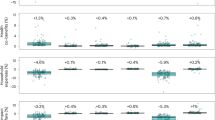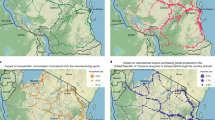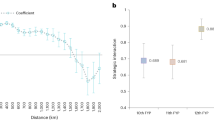Abstract
Geophysical hazards stress urban social, economic and political systems, but many studies focus on single locations over short periods. The manner in which a natural disaster propagates across cities globally through urban trade networks remains unexplored. Starting from a novel empirical baseline model for global production and trade, here we develop a dynamical model for the spread of individual cyclone impacts across the world’s cities. We find that cities are vulnerable to economic harm even if they are geographically distant from the location of direct impacts of cyclones. These adverse secondary impacts are responsible for up to three-fourths of the effects of the largest storms and are generated primarily by cyclone exposure in North America and East Asia, in part because of the roles of these regions as principal purchasers and suppliers, respectively, of industrial materials. Vulnerability to adverse secondary impacts of cyclones is highest in cities that are strongly dependent on the global trade network but have relatively few suppliers. Our results suggest that, in addition to improvements in protective infrastructure, urban adaptation to storm damage and climate change might require modifications to trade network linkages.
This is a preview of subscription content, access via your institution
Access options
Access Nature and 54 other Nature Portfolio journals
Get Nature+, our best-value online-access subscription
$29.99 / 30 days
cancel any time
Subscribe to this journal
Receive 12 digital issues and online access to articles
$119.00 per year
only $9.92 per issue
Buy this article
- Purchase on Springer Link
- Instant access to full article PDF
Prices may be subject to local taxes which are calculated during checkout




Similar content being viewed by others
Data availability
The data that support the findings of this study are available from the corresponding author upon request.
Code availability
Simulation code can be accessed at https://github.com/chrisshughrue/GlobalUrbanCycloneImpactSimulation.
References
Summary for Policymakers. In IPCC Special Report on the Ocean and Cryosphere in a Changing Climate (eds Pörtner, H.-O. et al.) (2019).
Summary for Policymakers. In Global Warming of 1.5 °C (eds Masson-Delmotte, V. et al.) (WMO, 2018).
EM-DAT: The International Disaster Database (CRED, 2009); www.emdat.be
Emanuel, K. A. Downscaling CMIP5 climate models shows increased tropical cyclone activity over the 21st century. Proc. Natl Acad. Sci. USA 110, 12219–12224 (2013).
Mendelsohn, R. et al. The impact of climate change on global tropical cyclone damage. Nat. Clim. Change 2, 205–209 (2012).
Rozenblat, C. & Pumain, D. in Cities in Globalization: Practices, Policies, Theories (eds Taylor, P. et al.) 130–156 (Routledge, 2007).
Levermann, A. Climate economics: make supply chains climate-smart. Nature 506, 27–29 (2014).
Felbermayr, G. & Gröschl, J. Naturally negative: the growth effects of natural disasters. J. Dev. Econ. 111, 92–106 (2014).
O’Brien, K. L. & Leichenko., R. M. Double exposure: assessing the impacts of climate change within the context of economic globalization. Glob. Environ. Change 10, 221–232 (2000).
Davis, M. Late Victorian Holocausts: El Niño Famines and the Making of the Third World (Verso, 2002).
Vespignani, A. Predicting the behavior of techno-social systems. Science 325, 425–428 (2009).
Ganesh, A., Massoulié, L. & Towsley, D. The effect of network topology on the spread of epidemics. In Proc. IEEE 24th Annual Joint Conference of the IEEE Computer and Communications Societies Vol. 2 1455–1466 (IEEE, 2005).
Hussain, M. M. & Howard, P. N. What best explains successful protest cascades? ICTs and the fuzzy causes of the Arab Spring. Int. Stud. Rev. 15, 48–66 (2013).
Helbing, D. Globally networked risks and how to respond. Nature 497, 51–59 (2013).
Henriet, F., Hallegatte, S. & Tabourier, L. Firm-network characteristics and economic robustness to natural disasters. J. Econ. Dyn. Control 36, 150–167 (2012).
Barrot, J.-N. & Sauvagnat, J. Input specificity and the propagation of idiosyncratic shocks in production networks. Q. J. Econ. 131, 1543–1592 (2016).
Hallegatte, S. & Dumas, P. Can natural disasters have positive consequences? Investigating the role of embodied technical change. Ecol. Econ. 68, 777–786 (2009).
Todo, Y., Nakajima, K. & Matous, P. How do supply chain networks affect the resilience of firms to natural disasters? Evidence from the Great East Japan Earthquake. J. Reg. Sci. 55, 209–229 (2015).
Cavallo, E. et al. Catastrophic natural disasters and economic growth. Rev. Econ. Stat. 95, 1549–1561 (2013).
Inoue, H. & Todo, Y. Propagation of negative shocks across nation-wide firm networks. PloS ONE 14, e0213648 (2019).
Inoue, H. & Todo, Y. Firm-level propagation of shocks through supply-chain networks. Nat. Sustain. 2, 841–847 (2019).
Boehm, C. E., Flaaen, A. & Pandalai-Nayar, N. Input linkages and the transmission of shocks: firm-level evidence from the 2011 Tōhoku earthquake. Rev. Econ. Stat. 101, 60–75 (2019).
Wenz, L. & Levermann, A. Enhanced economic connectivity to foster heat stress-related losses. Sci. Adv. 2, e1501026 (2016).
Shughrue, C. & Seto, K. C. Systemic vulnerabilities of the global urban-industrial network to hazards. Climatic Change 151, 173–187 (2018).
Shughrue, C. Global Urban Interdependencies and Systemic Risks in a Changing Climate. PhD dissertation, Yale Univ. (2018).
Sassen, S. The Global City: New York, London, Tokyo (Princeton Univ. Press, 1991).
Neal, Z. P. The duality of world cities and firms: comparing networks, hierarchies, and inequalities in the global economy. Glob. Netw. 8, 94–115 (2008).
Beaverstock, J. V., Smith, R. G. & Taylor, P. J. A roster of world cities. Cities 16, 445–458 (1999).
O’Brien, K. et al. Mapping vulnerability to multiple stressors: climate change and globalization in India. Glob. Environ. Change 14, 303–313 (2004).
Hallegatte, S. et al. Future flood losses in major coastal cities. Nat. Clim. Change 3, 802–806 (2013).
Kahn, M. E. et al. Long-term macroeconomic effects of climate change: a cross-country analysis Working Paper No. 26167 (NBER, 2019).
World Urbanization Prospects: The 2011 Revision (DESA, 2014).
Tropical Cyclones Wind Speed Buffers 1969–2009 (UNEP/GRID, 2011); http://sids.grid.unep.ch/layers/geonode:GRID_Cyclones_buffers
Hallegatte, S. An adaptive regional input–output model and its application to the assessment of the economic cost of Katrina. Risk Anal. 28, 779–799 (2008).
Hsiang, S. M. & Jina, A. S. The Causal Effect of Environmental Catastrophe on Long-Run Economic Growth: Evidence from 6,700 Cyclones Working Paper No. 20352 (NBER, 2014).
Lenzen, M. et al. Mapping the structure of the world economy. Environ. Sci. Technol. 46, 8374–8381 (2012).
Acknowledgements
Comments and suggestions from E. Lazarus helped us improve the manuscript.
Author information
Authors and Affiliations
Contributions
C.S., B.W. and K.C.S. conceived the study and developed model dynamics. C.S. designed the simulation and performed the analyses. B.W. and K.C.S. supervised and provided extensive feedback on the analysis and text. All authors discussed the results and contributed to the final manuscript.
Corresponding author
Ethics declarations
Competing interests
The authors declare no competing interests.
Additional information
Publisher’s note Springer Nature remains neutral with regard to jurisdictional claims in published maps and institutional affiliations.
Extended data
Extended Data Fig. 1 Impacts over time for four cities.
Direct, secondary, and total impacts versus time following a single large storm striking Seoul, New York City, Colombo, and Mysore.
Extended Data Fig. 2 Production change over time at city, national, and global scales.
Fractional change in production versus time at the city, country, and global scale by industrial sector for a single large storm striking Mysore, India.
Extended Data Fig. 3 Industrial sector price over time at city, national, and global scales.
Fractional change in unitary industrial input price versus time at the city, country, and global scale by industrial sector for a single large storm striking Mysore, India.
Extended Data Fig. 4 Impacts over time following earthquake scenarios.
Direct (orange), secondary (blue), and total impacts (grey) to the economy of Japan in value added USD versus time for 2011 earthquake (A) and Nankai earthquake scenarios (B).
Extended Data Fig. 6 Map of historical cyclone tracks.
Cyclone tracks (purple polygons) between 1968 and 20093.
Extended Data Fig. 7 Sensitivity of results to parameters.
Root-mean square deviation of supply output normalized by baseline parameter output. Parameters are varied between 50% and 150% of the baseline value, with 100% representing the baseline parameter. Parameter sensitivity is calculated among randomly selected storms from the dataset.
Supplementary information
Supplementary Information
Supplementary Table 1, Discussion and Figs. 1–7.
Rights and permissions
About this article
Cite this article
Shughrue, C., Werner, B. & Seto, K.C. Global spread of local cyclone damages through urban trade networks. Nat Sustain 3, 606–613 (2020). https://doi.org/10.1038/s41893-020-0523-8
Received:
Accepted:
Published:
Issue Date:
DOI: https://doi.org/10.1038/s41893-020-0523-8
This article is cited by
-
A spatially-explicit harmonized global dataset of critical infrastructure
Scientific Data (2022)
-
The Effect of Natural Hazard Damage on Manufacturing Value Added and the Impact of Spatiotemporal Data Variations on the Results
International Journal of Disaster Risk Science (2022)
-
Geographic delay characterization of railway systems
Scientific Reports (2021)
-
Natural disasters' influence on industrial growth, foreign direct investment, and export performance in the South Asian region of Belt and road initiative
Natural Hazards (2021)
-
Storm damages and inter-city trade
Nature Sustainability (2020)



